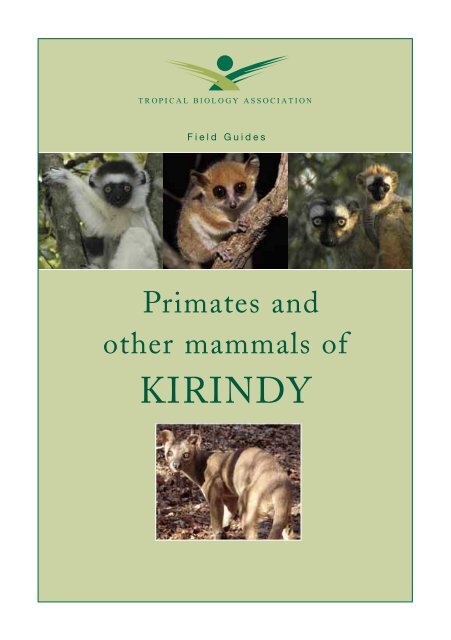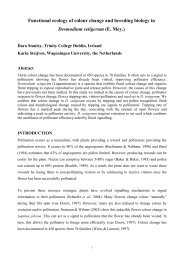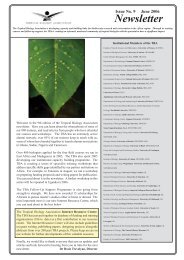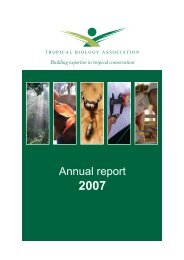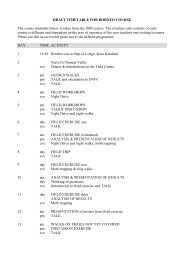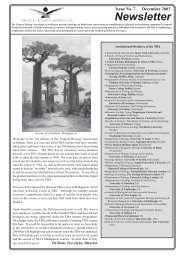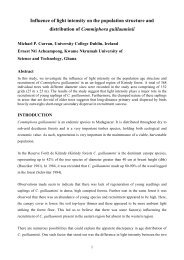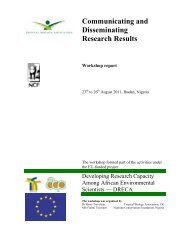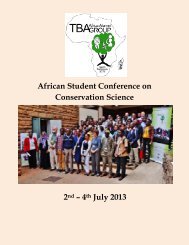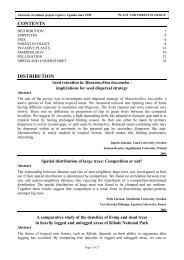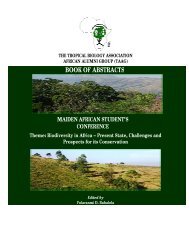primates and other mammals of Kirindy - Tropical Biology Association
primates and other mammals of Kirindy - Tropical Biology Association
primates and other mammals of Kirindy - Tropical Biology Association
- No tags were found...
Create successful ePaper yourself
Turn your PDF publications into a flip-book with our unique Google optimized e-Paper software.
Field GuidesPrimates <strong>and</strong><strong>other</strong> <strong>mammals</strong> <strong>of</strong>KIRINDY
KIRINDY FOREST AND ITS MAMMALS<strong>Kirindy</strong> is a dry deciduous forest covering about 12 000 hectares <strong>and</strong> is managed by theCentre de Formation Pr<strong>of</strong>essionelle Forestière (CFPF). Dry deciduous forests areamong the world’s most threatened ecosystems, <strong>and</strong> in Madagascar they have beenreduced to 3 per cent <strong>of</strong> their original extent. Located in Central Menabe, <strong>Kirindy</strong>forms part <strong>of</strong> a conservation priority area <strong>and</strong> contains several locally endemic animal<strong>and</strong> plant species.<strong>Kirindy</strong> supports eight species <strong>of</strong> lemur; Madagascar’s largest predator, the fossa; <strong>and</strong><strong>other</strong> unusual vertebrates such as the giant jumping rat. <strong>Kirindy</strong>’s plants are equallynotable <strong>and</strong> include two species <strong>of</strong> baobab, as well as the Malagasy endemichazomalany tree (Hazomalania voyroni).Animals that are endemic to the Menabe region include the giant jumping rat(Hypogeomys antimena), the narrow-striped mongoose (Mungotictis decimlineatadecimlineata), Berthe’s mouse lemur (Microcebus berthii) <strong>and</strong> the Madagascar flat-tailedtortoise (Pyxis planicaudata).This guide describes the lemurs <strong>of</strong> <strong>Kirindy</strong> forest alongside three <strong>other</strong> large <strong>mammals</strong>that are specialities <strong>of</strong> the forest.This document was developed during <strong>Tropical</strong> <strong>Biology</strong> <strong>Association</strong> field courses in <strong>Kirindy</strong>. It wasdrawn together by Rosie Trevelyan <strong>and</strong> the TBA staff. We would like to thank all our TBA alumni<strong>and</strong> teachers who have allowed us to use their photos for this guide. A special thanks to ManfredEberle, Kate Lessells <strong>and</strong> Scott Armbruster. This publication was funded by the EuropeanCommission (B7-6200/01/0370/ENV).© <strong>Tropical</strong> <strong>Biology</strong> <strong>Association</strong> 2007A Banson productionPrinted by Swaingrove
Field GuidesPrimates <strong>and</strong><strong>other</strong> <strong>mammals</strong> <strong>of</strong>KIRINDY
TBA Field GuideCONTENTSLEMURS 3LEMURIDAERed-fronted brown lemur – Eulemur fulvus rufus 4CHEIROGALEIDAEPale fork-marked lemur – Phaner furcifer pallescens 5Grey mouse lemur – Microcebus murinus 6Berthe’s mouse lemur – Microcebus berthae 6Coquerel’s dwarf lemur – Mirza coquereli 7Fat-tailed dwarf lemur – Cheirogaleus medius 7MEGALADAPIDAE (LEPILEMURIDAE)Red-tailed sportive lemur – Lepilemur ruficaudatus 8INDRIDAEVerreaux’s sifaka – Propithecus verreauxi verreauxi 9OTHER INTERESTING MAMMALS 10VIVERRIDAEFossa – Cryptoprocta ferox 10HERPESTIDAENarrow-striped mongoose – Mungotictis decemlineata decemlineata 11NESOMYINAEGiant jumping rat – Hypogeomys antimena 12REFERENCES 132
Mammals <strong>of</strong> <strong>Kirindy</strong>LEMURSAll 71 species <strong>and</strong> subspecies <strong>of</strong> lemur are endemic to Madagascar. The isl<strong>and</strong> separatedfrom the mainl<strong>and</strong> <strong>of</strong> Africa some 140 million years ago, which is before modern<strong>mammals</strong>, including lemurs, appear in the fossil record. It appears that lemurs colonizedMadagascar through a single dispersion event by crossing the Mozambique channel, afterwhich they radiated into the groups that we see today.Extant lemurs are divided into five families, though 2000 years ago there were a furtherthree families <strong>and</strong> 16 species which are now all extinct.The five living families <strong>of</strong> lemurs are:Lemuridaebamboo lemurstrue lemurs*ruffed lemursCheirogaleidaefork-marked lemurs*mouse lemurs*dwarf lemurs*Megaladapidae (Lepilemuridae)sportive lemurs* (seven species within a single genus Lepilemur)Indridaewoolly lemurssifaka*indriDaubentoniidaeaye aye*Lemurs found in <strong>Kirindy</strong>3
Mammals <strong>of</strong> <strong>Kirindy</strong>LEMURIDAEDivided into two subfamiles, the truelemurs (Lemurinae) <strong>and</strong> bamboo lemurs(Hapalemurinae). In <strong>Kirindy</strong>, the family isrepresented by genus Eulemur.Red-fronted brown lemurEulemur fulvus rufusCharacteristics Coat colour is reddishbrown.Behaviour Diurnal behaviour coupled withnocturnal activity (known as cathemeralactivity). Live in matrilineal groups <strong>of</strong>approximately three females <strong>and</strong> four males.Groups are territorial. The dominant malesires 60 per cent <strong>of</strong> the infants in the groupsstudied in <strong>Kirindy</strong>.Diet Mainly fruit.Size Body is ~450mm; tail is ~525mm; <strong>and</strong>weight is 2.3kg.Status Least concern (IUCN).4
CheirogaleidaeCHEIROGALEIDAEAll members <strong>of</strong> this family are nocturnal,sleeping in nests or tree holes by day. Somespecies undergo prolonged sessions <strong>of</strong>torpor.Pale fork-marked lemurPhaner furcifer pallescensCharacteristics Distinct black y-shapedlines running from their eyes, joining atthe top <strong>of</strong> the head (the “fork mark”). Thiscontinues down the back, including the tail.Behaviour Nocturnal. Very territorial<strong>and</strong> can be heard throughout the nightin <strong>Kirindy</strong>. Live in pairs: females aredominant. They forage alone, spending90 per cent <strong>of</strong> their time apart. Mostinteractions between males <strong>and</strong> femalesare conflicts over food – the female wins.Diet They specialize on tree exudates(gum) <strong>and</strong> defend territories containinggum-producing trees. In <strong>Kirindy</strong>, thegenus Terminalia forms the main source<strong>of</strong> their diet. They also eat the secretions<strong>of</strong> insects.Size Head <strong>and</strong> body length ~250mm; tail~300mm; <strong>and</strong> weight is ~460g.Status Data deficient (IUCN).5
Mammals <strong>of</strong> <strong>Kirindy</strong>Grey mouse lemurMicrocebus murinusCharacteristics Very small mouse-likelemur with a grey back <strong>and</strong> <strong>of</strong>f-whiteunderparts. Note the white patch on itsnose <strong>and</strong> dark eye-rings. Mouse lemurs canbe seen rapidly scurrying <strong>and</strong> leapingamong the trees.Behaviour Nocturnal. Both sexes foragealone at night in multiple overlappinghome ranges. Males increase their homeranges during the mating season <strong>and</strong> canleave sperm plugs to reduce competition.Both sexes undergo torpor during the day:males sleep alone while related femalessleep together. Adult females hibernate forseveral weeks each year; males hibernate foronly a few days at a time.Berthe’s mouse lemurMicrocebus berthaeCharacteristics Red head, rufous-looking,cinnamon round eyes, line down back.Behaviour Nocturnal. They are solitary –female ranges show little overlap whilemale ranges are more dispersed. If caughtunder a flashlight at night they are morelikely to freeze than run away like <strong>other</strong>mouse lemurs.Size This is the smallest primate species inthe world. Its body weight is ~30g (agorilla’s body weight is ~160kg). Bodylength ~61mm; tail length ~136mm.Status Endangered (IUCN).Diet Largely fruit but can eat insects.Size Head <strong>and</strong> body length ~125mm <strong>and</strong>tail ~135mm; females are 17 per cent largerthan the males; weight ~109g.Status Least concern (IUCN).6
CheirogaleidaeCoquerel’s dwarf lemurMirza coquereliCharacteristics Coquerel’s dwarf lemursare brown or grey-brown, with large ears<strong>and</strong> a long bushy tail. The large ears <strong>and</strong>sharp, pointed nose are distinguishingfeatures.Behaviour Nocturnal. They forage aloneat night <strong>and</strong> males <strong>and</strong> females haveseparate home ranges <strong>of</strong> 1-4ha. M<strong>other</strong>scarry the young by mouth <strong>and</strong> park themwhile foraging. Coquerel’s dwarf lemurs donot hibernate, but are less active on coldernights. They build spherical nests about2-10m above the ground.Diet Omnivorous: feeds on fruits, flowers,gum, spiders, frogs, insects <strong>and</strong> even onsmaller mouse lemurs.Size Head <strong>and</strong> body length is ~200mm;tail length is ~330mm; weight ~305g.Status Vulnerable (IUCN).Fat-tailed dwarf lemurCheirogaleus mediusCharacteristics Fawn-grey on the dorsalcoat <strong>and</strong> cream white underneath. Notethe dark rings round the eyes.Behaviour Nocturnal. These lemurs havethe unusual behaviour <strong>of</strong> hibernating in treeholes for six to eight months during the dryseason. During hibernation, they do notfeed, relying on stored fat reserves, some <strong>of</strong>which are in the tail – hence the name. Fattaileddwarf lemurs live in small familygroups (an adult male, a female pair <strong>and</strong>one or two <strong>of</strong>fspring). Both males <strong>and</strong>females take part in raising the young.Territories are 1-2ha <strong>and</strong> are marked bysmearing faeces on to trees.Diet Omnivorous: feeds on fruits, flowers,seeds, gum, insects.Size Head <strong>and</strong> body length is ~200mm;tail length is ~250mm; weight ~200g.Status Data deficient (IUCN).7
Mammals <strong>of</strong> <strong>Kirindy</strong>MEGALADAPIDAE(LEPILEMURIDAE)Nocturnal, vertical clingers <strong>and</strong> leapers,with legs that are elongated compared totheir trunks <strong>and</strong> arms. Leaves constitute thebulk <strong>of</strong> their diet.Red-tailed sportive lemurLepilemur ruficaudatusCharacteristics The overall body is greybrown.Note the reddish tail.Behaviour Nocturnal. They live in pairs insmall home ranges <strong>of</strong> 0.3-1.2ha but foragesolitarily. The males grunt whilst femaleschatter. They sleep in tree holes by day; thisspecies does not hibernate.Locomotion Vertical clinging <strong>and</strong> leaping(compared with Cheirogaleus, which movesquadrupedally).Diet Almost exclusively eats leaves. Thisspecies has one <strong>of</strong> the lowest recordedmetabolic rates for <strong>mammals</strong>, which may bean adaptation to its low-quality diet.Size Body length is ~280mm; tail length is~255mm; <strong>and</strong> weight is ~800g.Status Vulnerable (IUCN).8
IndridaeINDRIDAEThis family contains the largest livinglemur – the indri. In <strong>Kirindy</strong>, the family isrepresented by the sifaka. This name comesfrom the animal’s characteristic threatbehaviour in which it issues an explosive,hiss-like “shee-faak” <strong>and</strong> jerks its headrapidly backwards.Verreaux’s sifakaPropithecus verreauxi verreauxiCharacteristics White body <strong>and</strong>black/brown crown.Behaviour Easily spotted clingingvertically to a tree trunk during the day.Sifakas are powerful jumpers in the treesbut on the ground they hop <strong>and</strong> boundbipedally, <strong>of</strong>ten with arms held above thehead. They live in small matrilineal groups<strong>of</strong> approximately two related females <strong>and</strong>two unrelated males where the females aresocially dominant.Diet Leaves, fruit, flowers <strong>and</strong> bark.Size Body size is ~430mm; tail length is~580mm; <strong>and</strong> weight is 3.5kg.Status Vulnerable (IUCN).9
Mammals <strong>of</strong> <strong>Kirindy</strong>OTHERINTERESTINGMAMMALSCarnivora/VIVERRIDAEFossaCryptoprocta feroxThe largest mammalian carnivore inMadagascar. Top <strong>of</strong> food chain.Characteristics Brown upper parts <strong>and</strong>cream underparts. The head is similar to amongoose’s with a broader muzzle. Its tailaids balance when climbing trees but is notprehensile.Behaviour A very agile mammal. It wasbelieved that fossa were completelynocturnal, but studies show this belief wasformed more because <strong>of</strong> their rarity. Theyare active during the day <strong>and</strong> at night,depending on season <strong>and</strong> prey availability.Diet The predominant predator for manyspecies in the region, it eats small- tomedium-sized animals, from fish to birds,<strong>and</strong> even hunts lemurs.Size Length ~1.4m, tail is roughly thesame length as the body; weight ~6.7kg.Status Endangered (IUCN).10
HerpestidaeCarnivora/HERPESTIDAENarrow-striped mongooseMungotictis decemlineata decemlineataThis subspecies <strong>of</strong> mongoose is endemic tothe dry deciduous forests <strong>of</strong> the Menaberegion.Characteristics Eight to 10 dark stripes onits back <strong>and</strong> sides; known to the localMalagasy people as boky boky because <strong>of</strong> thesound it makes.Behaviour Diurnal <strong>and</strong> can be bothterrestrial <strong>and</strong> arboreal; lives in variablegroups <strong>of</strong> up to 10 individuals.Diet Mostly insects, but will also eatsmall vertebrates, birds’ eggs <strong>and</strong> <strong>other</strong>invertebrates.Size Body length is ~350mm; <strong>and</strong> weightis ~2.2kg.Status Endangered (IUCN).11
Mammals <strong>of</strong> <strong>Kirindy</strong>NESOMYINAEAn endemic subfamily. This species isendemic to the region.Giant jumping ratHypogeomys antimenaCharacteristics The largest rodent inMadagascar is the giant jumping rat;rabbit-like with conspicuous large ears, longhind legs <strong>and</strong> short forelegs. Found only intwo forest blocks in Menabe, it is one <strong>of</strong>Madagascar’s most endangered <strong>mammals</strong>.Behaviour Territorial, with a range <strong>of</strong>around 3.5ha. Nocturnal, living in burrowsby day. Monogamous; the male contributesto the care <strong>of</strong> young. One <strong>of</strong>fspringnormally produced per litter.Locomotion Walks on all four limbs.Diet Fruit, seeds, leaves <strong>and</strong> young shootson the forest floor.Size Body length ~330mm excluding thetail; weight ~1.3kg.Status Endangered (IUCN).12
ReferencesREFERENCESGerman Primate Center. Accessed on 27 October2006 at www.dpz.gwdg.de/sociobiology/Mada/lemurs.htm.Goodman, S.M. & Benstead, J.P. 2003. The NaturalHistory <strong>of</strong> Madagscar. University <strong>of</strong> Chicago Press,USA.Knoxville Zoo animal information. Accessed on27 September 2006 at www. knoxville-zoo.org.Mittermeier, R., Konstant, W., Hawkins, F., Louis,E., Langr<strong>and</strong>, O., Ratsimbazafy, J., Rasoloarison,R., Ganzhorn, J., Rajaobelina, S., Tattersall, I. <strong>and</strong>Meyers, D. 2006. Lemurs <strong>of</strong> Madagascar.Conservation International, USA.Rowe, N. 1996. The Pictorial Guide to LivingPrimates. Pogonias Press, USA.Wild Madagascar. Accessed on 27 September 2006 atwww.wildmadagascar.org/wildlife/species.PHOTOSManfred EberleCheirogaleus mediusMicrocebus berthaePhaner furcifer pallescensMirza coquereliMicrocebus murinusLepilemur ruficaudatusKate LessellsEulemur fulvus rufusScott ArmbrusterCryptoprocta ferox<strong>Tropical</strong> <strong>Biology</strong> <strong>Association</strong>Propithecus verreauxi verreauxiMungotictis decemlineata decemlineataHypogeomys antimenaTBA has endeavoured to attribute photoscorrectly <strong>and</strong> seek permission for their use.If, however, a mistake has been made,please contact TBA, who will make everyeffort to correct it in subsequent printings.13
Mammals <strong>of</strong> <strong>Kirindy</strong>This guide was developed to help participants on <strong>Tropical</strong> <strong>Biology</strong><strong>Association</strong> field courses to learn about the <strong>primates</strong> <strong>and</strong> <strong>other</strong>interesting <strong>mammals</strong> <strong>of</strong> <strong>Kirindy</strong> forest. It is not designed to be acomplete field guide. It provides notes on their characteristics,ecology <strong>and</strong> behaviour to help the reader distinguish them from<strong>other</strong> <strong>Kirindy</strong> species.<strong>Tropical</strong> <strong>Biology</strong> <strong>Association</strong>The <strong>Tropical</strong> <strong>Biology</strong> <strong>Association</strong> is a non-pr<strong>of</strong>it organizationdedicated to providing pr<strong>of</strong>essional training to individuals <strong>and</strong>institutions involved in the conservation <strong>and</strong> management <strong>of</strong>tropical environments. The TBA works in collaboration withAfrican institutions to develop their capacity in natural resourcemanagement through field courses, training workshops <strong>and</strong> followupsupport.European OfficeAfrican OfficeDepartment <strong>of</strong> ZoologyNature KenyaDowning Street PO Box 44486Cambridge CB2 3EJ00100 – Nairobi, KenyaUnited Kingdom Tel: +254 (0) 20 3749957Tel: +44 (0) 1223 336619 or 20 3746090e-mail: tba@tropical-biology.orge-mail: tba-africa@tropical-biology.orgFunded by the European Commission (B7-6200/01/0370/ENV)


